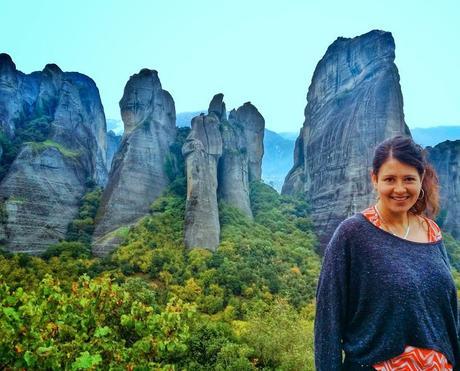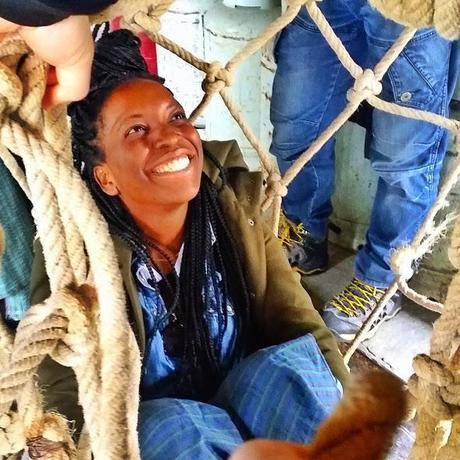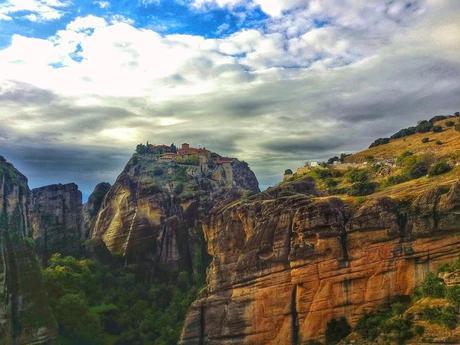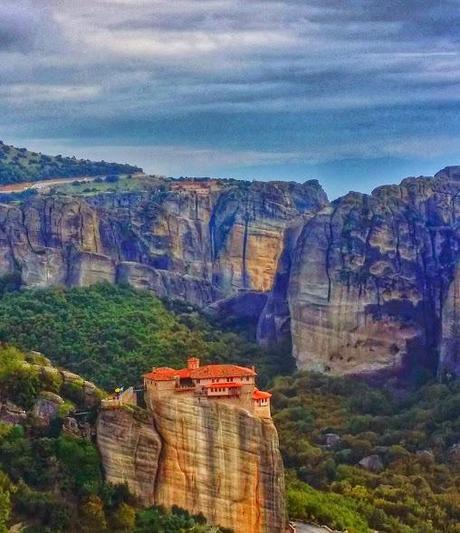Meteora has an otherworldly appearance. It doesn’t look as if it belongs on this earth, and perhaps it doesn’t.
The name Meteora comes from the word Meteor that means suspended, which is what the monasteries atop the natural sandstone massifs appear to be. Or perhaps it refers to the monk’s sought out mental state, …so different from those of us stuck back down here on earth.

Meteora is Greece’s second largest monastic community. The first is Mount Athos. In it’s hey day back in the beginning of the 14th century there were 24 monasteries. Now just six remain, with the rest in ruins.
OK, but getting back to those adventurous monks, which is what you really want to know about right? Some might even call them dare devils. Oops, perhaps, that’s not a good word to associate with monks…but I digress…

Me feeling very small in front of the huge sand-stone towers at Meteora.
Back in the day, there were only two ways to reach the monasteries 1) rock climbing the vertical sandstone columns:

Varlaam Monastery, the second largest monastery in Meteora, and the one I visited.
or 2) being hosted up 373m in a basket made of ropes:

It’s either this or rock climbing, either way it’s over 300 vertical meters! Brave volunteer Zim demonstrated how it worked, but only made it 1 meter.
Seriously, what a choice! Regardless either qualifies as an adventure, don’t you think? And once again, I’ve got my impression of monks all wrong! The first time was in Norcia, Umbria, when I met a Benedict monk. With a mischievous glint in his eye, he told me I have a lover…. My eyes grew wide…..His name is God! he said as he laughed! So not only can monks have a sense of humour, they can also rock climb. Who knew?

Varlaam Monastery. If you only have time to visit one of the monasteries, this was the one my guide recommended.
Flash forward to the present day and things have changed. Roads have been built and all the monasteries are open to the public, which is why according to my guide Sophia, that the number of monasteries has declined. Monos means alone and monastic translates as to go away to be alone – something that is in direct contrast to being a tourist destination.

Safely assuming that you aren’t seeking the monastic lifestyle, (I have very few monk readers that I’m aware of) Meteora is an incredible place to visit. It’s one of those destinations that will have you saying WOW over and over again! It is very deservedly a UNESCO World Heritage Site. My visit to Meteora lasted only a few hours, so check out Laurence’s photos from Finding the Universe, who spent several days exploring the region.
Make the Most of You Visit to Meteora with these tips from my guide Sophia:
- While it’s possible to drive or take a bus up, for a truly special experience hike up at dawn to catch the sunrise. It’s safe to do on your own without a guide.
- Every monastery has their own opening hours and many close for 2-3 hours in the afternoon during summer, so ask your hotel in Kalambaka (the nearest town) for the schedule of all the monasteries.
- If you want to see all six monasteries, allow yourself six days. If you don’t have time to see all six, see these three:
- The Holy Monastery of Varlaam (the one I visited). It’s the second largest found at Meteora and was built in 1541.
- The Holy Monastery of St. Nicholas Anapausas (built in the middle of the 16th century)
- Holy Monastery of Rousano (founded in the middle of the the 16th century)
Getting to Meteora
Meteora is located just over 500km north of Athens. It takes ~ 5 hours to get there by car. Check out the map below from Athens to Meteora:
Note: My visit to Meteora was made possible by Visit Greece but as always all opinions are my own. They did not require me to rock climb or take a basked to visit the monasteries, they kindly drove me.

